
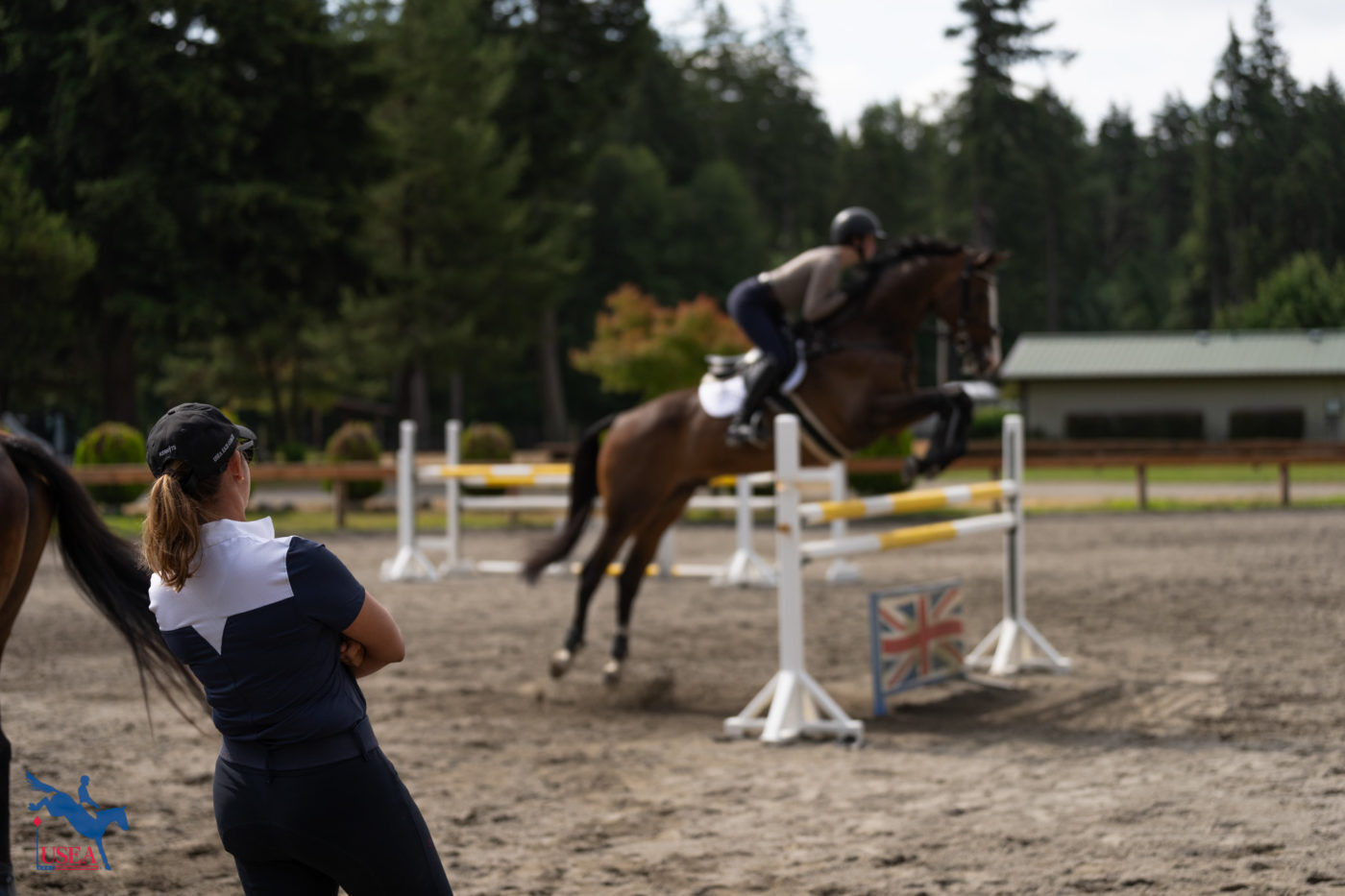
Yelm, Washington—Aug. 14—Correct jumping positions, generating a quality canter and keeping it rhythmic, and practicing good habits consistently were the takeaways from the second day of the 2024 USEA Emerging Athlete U21 (EA21) West Coast II Regional Clinic on Wednesday. Rebecca Brown, an elite eventer and EA21 coach, emphasized those factors and also gave plenty of advice about at-home training activities during the jumping sessions with the 12 participants at Aspen Farms.
The riders were split into four groups of three riders each, and they worked for about an hour per group over a course of nine show jumps that asked technical questions and even posed scenarios they might encounter during cross-country.
Wednesday’s action started at 7:30 a.m. with a short lecture by Brown in which she emphasized the need for participants to study and educate themselves on riding and training practices as well as the many grants and scholarships available to them to further their training opportunities. She also talked about what makes a good competitor, including the requisite hard work and focus, but also stressed that, “emotional control is a huge one. If you’re able to be around some of the top competitors and get to watch them, it’s very interesting to watch how they handle [pressure]. How people handle themselves and how they problem-solve is huge.”
That point was reinforced in the jumping sessions, where many participants experienced difficulties, initially, with some of the questions being asked. However, all ended their sessions on successful rounds.
“Ultimately, you have to have enough skills and enough tools in your toolbox so you can warm them up, and then throw down a competitive result,” Brown said. “And you have to have the emotional control to say, ‘OK, I’ve got to work my way through this.’”
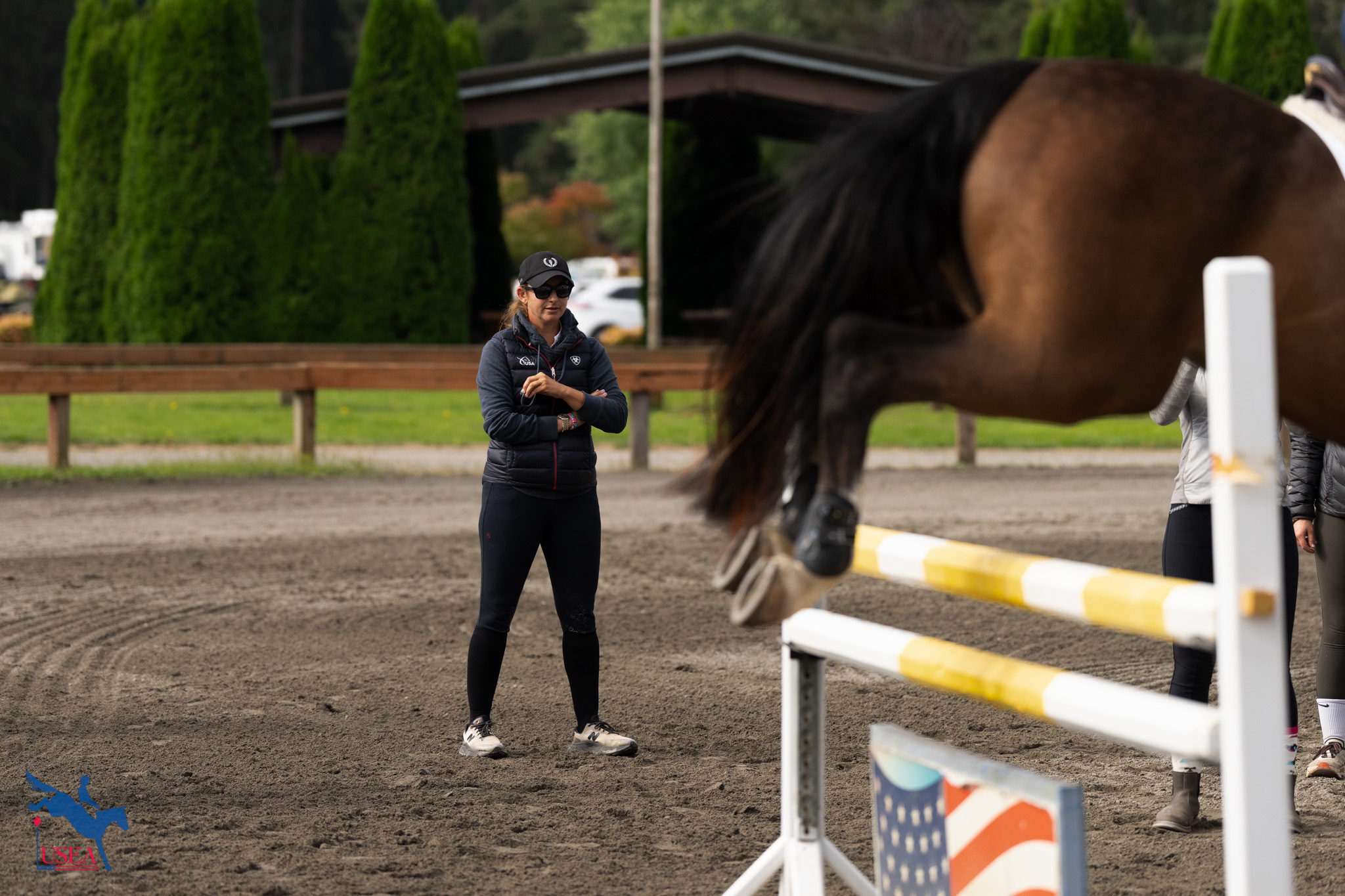
Brown also discussed the need to understand the correct positions utilized during the two jumping phases, including a light seat, a slightly forward lower leg for cross-country and a 45-degree angle for it during show jumping—no gripping with the knees, and ensuring the top cap of your boot is lined up with the front of your stirrup and the ball of your foot solidly in the stirrup.
“Our style is lighter. It’s the American Forward style. The position you choose is what works best for your horse, but the most important thing out of all of this is that there are no seat bones in show jumping,” she said, explaining that the American style stems from the days when the horses available to U.S. competitors were mostly Thoroughbreds, who require a lighter touch as opposed to the heavier European breeds.
Lastly, she said the German Training Scale (GTS) should form the basis for all training activities. She emphasized it heavily during Tuesday’s dressage sessions, which saw riders catch-riding each other’s horses. The GTS is a phased system that helps a rider to evaluate how a horse is going and determine how to prioritize what to work on. The six facets of GTS are rhythm, relaxation, connection, impulsion, straightness, and collection. There are three phases in the GTS, and the facets overlap within those phases.
She stressed that the GTS applies to all aspects of riding and is essential to know and use if you want to be successful.
“You used to not have to be really good at all three disciplines. You had to be OK at them. Now you have to be very, very good at all three,” she said. “The German Training Scale is important for all of the phases. I guarantee that if anyone has a struggle today, it’s going to be a flatwork-based issue.”
During the jumping sessions, Brown offered suggestions for at-home exercises and training techniques participants can use, including how to practice setting up for cross-country fences. Brown said she sets up a cone that’s six strides from a cross-country fence and then practices getting as close as possible to the cone before she begins to set up her horse. She also suggested practicing over different types of jumps and in different “gears” while staying out of the saddle, finding a way to gallop racehorses, and reading books by equestrian experts to further their equine education.
The jumping action got underway just before 9 a.m., with Ella Eisenbarth, 17, of Woodinville, riding Magic Mike (Grand Slam VDL x Blended by Liefhebber), a 7-year-old Dutch Warmblood gelding with whom she plans to move up to the two-star level this fall; Olivia Keye, 16, of Kalispell, Montana, and her 12-year-old Thoroughbred gelding of unrecorded breeding, Chromatic Flyer, with whom she competes at the two-star level; and Abigail Popa, 18, of Spokane, Washington, and Lutina (Luidam x Hadine Van't Zorgvliet), a 7-year-old Irish Sport Horse mare. They compete at the two-star level.
As with each group during the day, the participants first warmed up their horses, and then met with Brown in the center of the ring to discuss the plan for their session. Brown emphasized the importance of using the proper bits with horses and the need to ride assertively and accurately.
“File it under the millions of things we do for our horse that actually make it harder for them,” Brown said about bitting practices. “Sometimes there are tools in the toolbox that you reserve for those get ‘er done moments. But that can’t be how you operate on a daily basis.”
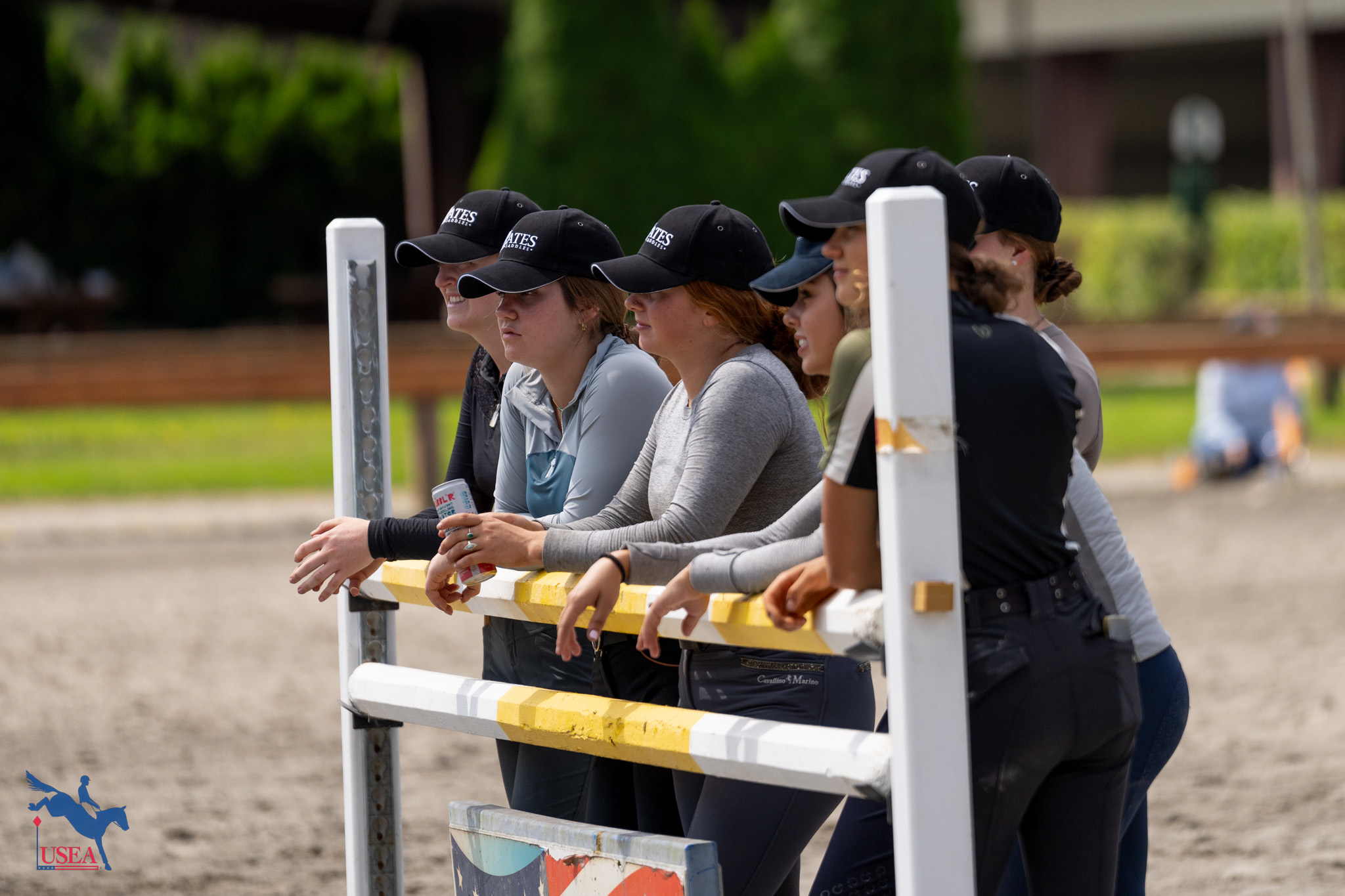
The three young women then warmed their horses up over a small vertical, one at a time, cantering it and then turning left or right to circle around and jump it again. Brown explained that she recommends using ground rails at home and filler for fences so they’re not too airy. She set up a landing rail for Keye and “Alvin” at 16’ out from the vertical. She said riders could work with the distance at home, rolling it in as close as 12’-13’.
“When you’re doing a landing rail, always be more cautious about the placement. I start with 16’ [away from jump]. I always set it a little bit farther away just to be cautious because I don’t want the horse to land on it,” she said, as Keye and Alvin came around to jump it the first time. The chestnut gelding spooked at it, knocking down the fence while stutter-stepping over the landing rail. However, Alvin quickly became more comfortable with the exercise and more responsive on the back side of the fence, reinforcing a point Brown made in her lecture.
“The back side of the jump is everything. The back side of a jump is the front side of the next jump,” she said.
Brown also stressed that riders must keep the correct position, cautioning Popa to correct her upper body quickly when landing off jumps.
“Do you know where you sit up? Four strides out. You should be sitting up on the back side,” Brown said. “I want you to land and stretch up.”
Brown also emphasized the need to form good habits and practice them regularly. After Eisenbarth did a course, she told her that “You do a lot of things really well, but then sometimes you get in front of a jump and are, like, ‘Hyah.’ You’ve just got to keep working on your habits and ultimately become more consistent. It’s all about good habits. You reduce risk in everything you do by developing good habits.”
After doing several show-jumping exercises, Brown had the riders prepare for a cross-country question set up using show jumps. She created a wide “corner” fence with a jump standard set just off center in the middle of the jump.
“How do you jump a corner?” Brown queried. “Ya’ll ready for some vocabulary? I just used my Texas accent, so get ready. You jump perpendicular to the bisection of the angle.”
In the midst of some confused stares, Brown said it in more simple terms. “Basically, you make a pie, cut the pie in half, and then you jump perpendicular to it,” she said, adding that she always looks up at “something in the distance” when jumping a corner.
A bending five-stride line from an oxer to the corner jump tested the participants accuracy, but all successfully answered the question. Another tough question was the vertical combination set 33’ apart for a tight two strides.
“B is the hard part,” Brown said. “In order to make B go smooth, you have to make the A go well, but so often, you see people make a hot mess of A.”
When Keye piloted Alvin through the bending five stride from an oxer to the vertical combination, Brown cautioned her and all participants to “Be very aware of where you’re looking. Be eagle eyed, and stay on your line.”
The morning’s second group included Harper Padgett, 16, of Woodinville, Washington, and her three-star partner Captivate (Cunningham x Dorothy’s Cabin), a 13-year-old Holsteiner-Thoroughbred cross; Caterina Ritson, also 16, of Ridgefield, Washington, and This Lad is Gold (Private Gold x This Ones a Riot), a 16-year-old Thoroughbred who’s moving up to Intermediate in September; and Hanni Sreenan, 18, from Hood River, Oregon, and her three-star competition partner, 17-year-old black Hanoverian gelding, Ebenholtz (Ehrentusch x Levantine).
Initially with the second group, Brown focused on foot position in the stirrup. “What you really want to do is open up your knee a bit, and put your weight on your toe,” she said.
She also discussed the importance of schooling with ground rails and not using airy fences at home. “Don’t get me wrong. You’ll have to jump those things sometimes, but that’s not how I want to train on the regular,” she said. “And always school with ground lines, even though you don’t have them at shows. It just encourages a consistent shape.”
With the three riders in the second session, all of whom are competing at a high level, she emphasized how exercises like the bending line to the corner jump are important for them to master.
“You have to be able to ride forward to your technical questions at the three-star level. You can’t add all the time,” she cautioned Sreenan. Then, as Ritson jumped the last fence of a round, she had her continue cantering and do the final three fences again, a bending five-stride line off an oxer to the short two-stride vertical combination.
“You have to keep adjusting,” Brown said to Ritson. “That’s what’s hard. You can have a plan but you gotta be ready…to adjust it as you get closer.”
For Padgett, Brown offered words of encouragement after “Cappy” stopped at a yellow vertical with a panel featuring the British flag on it underneath. “That’s where the conversation was too late. You came around the corner, and he got behind your leg. You’re coming around the corner too quiet. Find that rhythm, talk to him, and even when you want to slow down, it’s got to be leg to hand, up to the bridle. Even if you want to half-halt, you still need to rev that engine.”
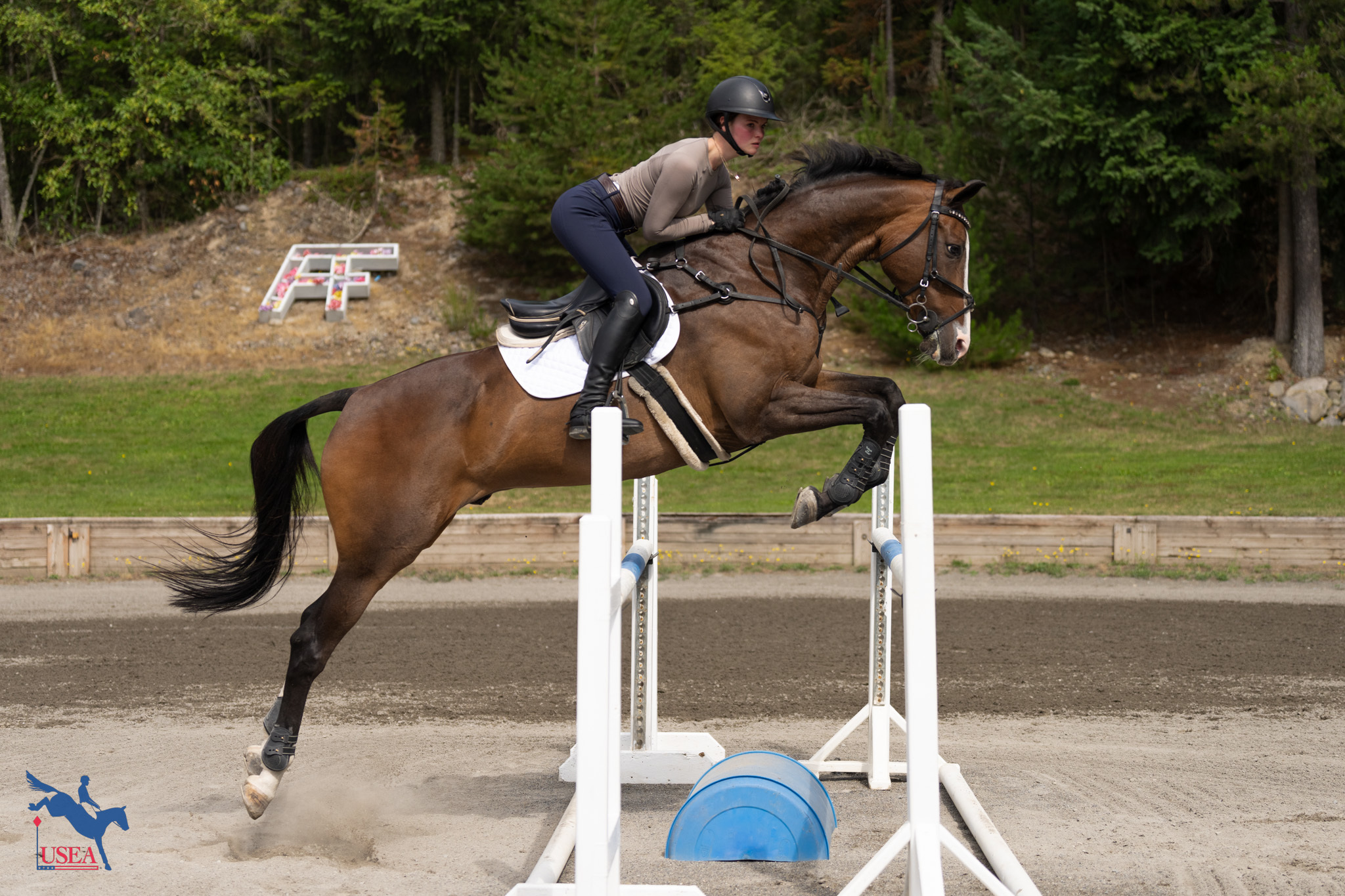
After another stop, she counseled Padgett to “Settle and give yourself a chance to see it, and squeeze, squeeze, squeeze,” at which point the duo nailed a perfect distance. “That was very good. You didn’t try for a flyer. You kept a feel, pushed him into the bridle, and let yourself see it.”
Padgett, who’s attended the EA21 clinics for the three years they’ve been run and also all three national EA21 camps, she said that while she and Cappy had some issues, ultimately, she learned a lot during her jumping session.
“I really got to see how the German Training Scale translates to coursework at height,” she said. “You’re not going to be perfect every single day. These are practice days, and I’m going to use the education I’ve gained from it. It’s nice for it to happen when someone can help with it.”
She’ll take those lessons with her as she heads to Virginia this week, where she’ll attend Foxcroft School in Middleburg, Virginia, and campaign on the East Coast.
Wednesday’s third jumping group featured three Preliminary-level competitors: Simone Clark, 17, from Seattle, riding 12-year-old Trakehner mare, Sunsprite Seryndipity (Steinburg x Symplicity); McLaine Mangum, 18, of Redmond, Washington, and Grantstown Mr. Big (Mr. Big Cat x Hollthill Grandpas Pet), an 11-year-old Irish Sport Horse gelding; and Kendal Smith, 19, of Sammamish, Washington, on Independer JWB (Zavall VDL x Operette), an 11-year-old British Sport Horse gelding.
Smith went first, and “Indie” stopped at the first jump. Brown had Smith continue to jump the gelding over the fence, using it as a moment to discuss how to address stops at home. “Because he wanted to turn away, he’s not allowed to turn away. That’s the thought process there,” she said.
For both Mangum and Clark, she emphasized rhythm. “Get the canter you want for the jump, and keep the rhythm,” she counseled McLaine. “Turns always hold your hand a little bit and give you shape, so you can ride forward through them and then take a little bit of a feel so you can maintain the canter.”
When Clark had a flyer, Brown recommended patience. “That’s OK,” she said. “Give yourself some options. Improve the canter. Keep going, don’t run, and count your rhythm.”
Brown had Clark watch a video of her first jump on the course so she could visualize the issue. “When you jumped that jump, what was your priority? The quality of the canter was not your priority. You landed and cared more about the lead change. You can’t do a lead change if the canter goes south…The jump is very small so be willing to be very disciplined with yourself. Your priority is landing and getting the correct canter back immediately, and then you stay the same and rinse and repeat, rinse and repeat.”
After another refusal, Brown offered words of support to Clark. “You have the skills. You just have to be a little hungrier and a little tougher on yourself because you’re allowing that. Get it back, and keep it no matter what,” she said of the canter.
“You’re still developing, and you’re allowed to make mistakes. You’ve got loads of talent, and you’re sitting on a nice horse. You just have to be disciplined up here,” Brown added, pointing to her head “And when in doubt, add, don’t go long.
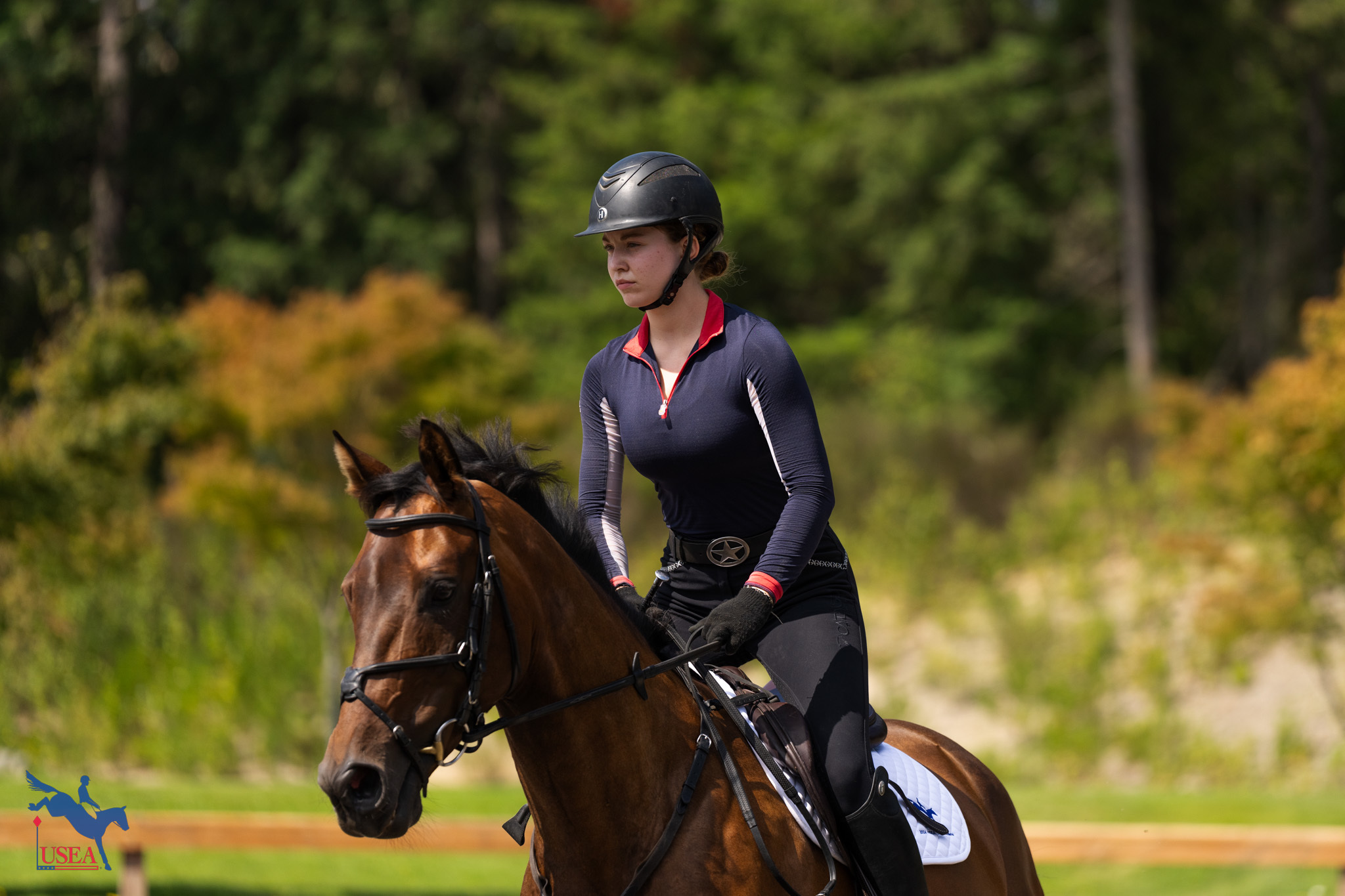
“You have to have the ability to take criticism, because it’s not really criticism. Plenty of trainers see riders with talent and push them. And I want to be clear, I see the talent, and I want to push you to be better,” she said to Clark, before addressing the whole group, bringing the conversation back around to the concept of emotional control. “The more experienced you get, the more you want to be yelled at. I have taken lessons where the trainer says ‘Yeah, that’s how you do it’ and I’m, like, “OK, I don’t have a gold medal yet. Rip on me. I’m hungry for it.’ ”
The fourth and final group included Shruti Bona, 19, of Duvall, Washington, and SRF Western Territory (Beaulieu's Quissini x Jetting West), a 10-year-old Selle Français mare that Bona borrowed to attend the EA21 clinic; Gabrielle Curtis, 19, of Seattle, and Big Sur (Lemon Drop Kid x Visit), a 16-year-old Thoroughbred with whom she competes at the Open Modified and Preliminary levels; and Kaylee Petticord, 19, of Enumclaw, Washington, and All That Jazz (Reversal x JustBluffin), an 11-year-old Thoroughbred mare with whom she competes at the two-star level.
Foot position again came up in the fourth group, as Brown cautioned Curtis to “make sure you don’t have too much foot in your stirrup. I want you to be able to keep your heel down a little bit more.”
Both Bona and Petticord’s horses were somewhat excitable initially, leading Brown to discuss the concept of ensuring you have a good canter rhythm and that you maintain it before and immediately after jumps.
“Count in your head. Settle down and see how slow you can go,” Brown said to Petticord, having her count strides between two oxers and attempt to add as many as she could. For Bona, who was only jumping “Sandy” for the second time, Brown used it as an opportunity to reinforce the importance of catch riding to the assembled group.
“You’re very adjustable, and the horses really like you, so keep it up,” Brown said to Bona, who said she often catch rides, before adding of her rounds with Sandy, “You’re doing a good job. Sometimes she’s a forward thing, and sometimes she backs off. It’s just about being a little more consistent in her canter everywhere. But you’ve only jumped her once. I think you are very good about being thoughtful and problem solving as you go along. You made her better and better.”
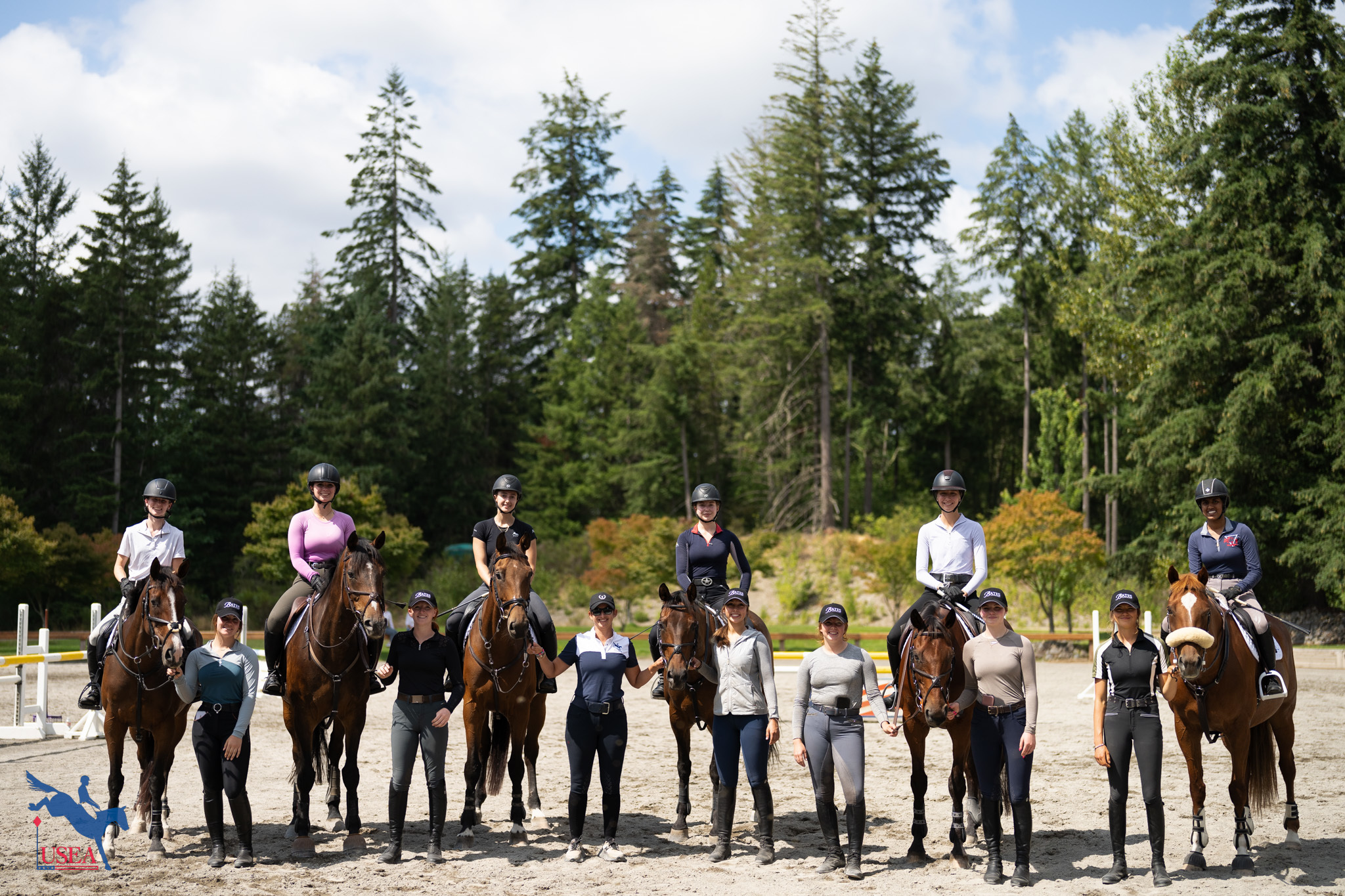
This year marked the final year that Brown will work with West Coast EA21 riders, as within the program, coaches will shift to cover regions, offering a fresh perspective to participants. After the day’s jumping sessions ended, Petticord hosed off “Jane” and said she’d miss working with Brown, from whom she said she’s learned a lot.
“I’ve been with Rebecca for the past three years, so her getting to see us years apart and improve was really cool,” said Petticord, who hopes to secure a working-student position with a trainer on the East Coast. She currently teaches lessons and trains horses in Washington. “I’m bummed that Rebecca won’t be here [next year] but it’ll be good to get some other viewpoints.”
The Participants:
Don't forget to follow the USEA’s coverage on social media!
Facebook | Instagram | Twitter
About the USEA Emerging Athlete U21 Program (EA21)
The purpose of the USEA Emerging Athletes U21 Program (EA21) is to identify and provide consistent quality instruction to the next generation of elite event riders. The aim is to create a pipeline for potential team riders by identifying and developing young talent, improving horsemanship and riding skills, and training and improving skills and consistency.
The USEA Emerging Athletes U21 Program was launched in 2022 with a model of five summertime regional clinics taught by selected USEA Eventing Coaches Program (ECP) instructors, leading to a winter national camp consisting of selected Young Riders from the regional clinics. Athletes who are 21 years or younger, are current members of their USEA Young Rider Area program, and are established at the Training Level or higher, are eligible to apply for the EA21 program. Click here to learn more about the USEA EA21 Program.
The USEA would like to thank ARMA, Kerrits, PulseVet, Ride iQ, Sidelines Magazine, Schneiders Saddlery and #WeRideTogetherfor sponsoring the USEA Emerging Athletes U21 Program.
Are you following along with the action from home this weekend? Or maybe you're competing at an event and need information fast. Either way, we’ve got you covered! Check out the USEA’s Weekend Quick Links for links to information including the prize list, ride times, live scores, and more for all the events running this weekend.
The Adams Horse Supply USEA Adult Team Championships (ATC) is the capstone event for the USEA Adult Team Challenges hosted throughout the year in all 10 Areas. The ATC provides adults competing in the Beginner Novice through Preliminary levels with the chance to compete as a team and represent their Area in a friendly and fun environment. To add even more excitement to this year’s ATC, title sponsor Adams Horse Supply is challenging all ATC riders to an additional quest that will bring them and their teammates even closer—a photo scavenger hunt across the Kentucky Horse Park!
Catching riding was the theme of the first day of action at the 2024 USEA Emerging Athlete U21 (EA21) West Coast II Regional Clinic on Tuesday at Aspen Farms, a 240-acre facility in Yelm, Washington, about 60 miles south of Seattle.
Sooner or later we’re all going to experience something that’ll leave us feeling a bit uncomfortable, doubtful or even afraid. High-velocity sports like riding often creates these kinds of emotions, but it’s the unpredictable nature of our horses that really fire the fear in many of us.